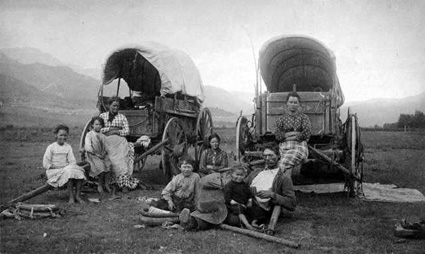You know how stuff that you were exposed to as a kid make you who you are really influence your life?
Well, the funny is thing is that I read a lot as a kid. And my favourite books in the whole world were the Little House books. Grandma had a set of nearly all the books and my favourite was the first one, "Little House in the Big Woods".
What I wanted tod o more than anything was to bake my own bread, grow my own food, make my own sugar, sew my own clothes, make my own soap, etc. etc. This continued, ebbing rather than abating even in adulthood. Even now, I love wearing sunbonnets and prairie dresses more than jeans and t-shirts. Sorry, world!
When I was about twelve, my mother bought me a copy of this book (the Australian version), which was basically a guide to the living the "Little House" life!
The moment that 100% lye "drain cleaner" became available in my country at Ace Hardware, I jumped right in.
The first attempts involved using meat scraps from the kitchen, rendering them to make into lard or tallow, then into soap.
 |
| Purified tallow |
 |
| Experimenting with stove-top hot-process soap |
 |
| Lamb tallow soap |
From my FB post:
Not raw, but I remember a discussion on using fat trimmings from soup and broth for frying. Since the price of food is going up, we can save leftover deep-frying oil to make household cleaning soap, and also trimmings from meat to make animal fat soaps. The thing is, the trimmings must be rendered on their own so that no salt contaminates the fat.
I just want to share my experiment (slightly weird ;) )
Picture 1 - 50 grams of mutton fat (beef/lamb/mutton) trimmed from steaks, rendered and clarified. This kind of fat is tallow and produces the hardest, firmest soap. Lard is also traditionally use in soapmaking. I have tried lard, chicken fat and tallow, but chicken fat is produces a much softer soap. I prefer to use waste products like this to start out rather than splurge on expensive organic vegetable oils (save $$$).
Picture 2 - You can buy ROOTO 100% lye drain cleaning crystals from most ACE hardwares. That is the sodium hydroxide for soap making. Then, use a soap calculator online to measure precisely (down to the gram) how much lye and water you need based on the soap. The solution is super caustic so you'll need rubber gloves besides other precautions.
Anything you use for soapmaking can only be used for soapmaking (don't use for food prep).
Now, the vegetarian soap making classes will teach you that the best method is cold-process, but that requires an immersion blender (around RM200!). The other option is hot-process, but that requires a slow cooker/crock pot AND an immersion blender (ca-ching, ca-ching).
I just use an OLD stainless steel saucepan and a spoon to stir and cook the soap over low heat, adding water until the mixture comes together. This takes quite a while, however, and since I didn't know what I was doing at first because there were NO instructions online it was super frustrating. Also I had to control the heat, because once it started boiling and splattering that got quite dangerous (and burned some holes on the stovetop).
Also, I've found the most affordable essential oils to be from "Soap Artisan" (they have several branches ie. in 1Utama). I spent RM20 to get Lavender essential oil.
Picture 3 - my final "recycled materials", earth-friendly soap below. Yes, it's not vegetarian or made through the superior cold-proess method but it's the good old-fashioned way people used to make soap (like on Little House On The Prairie).
Conclusion: My family is very scared to use my soap. I have made laundry soap, facial scrub soap and hand washing soap all from various animal fats, but they "gili". Sigh. It bubbles and foams and cleans just like store-bought soap though.
 |
| IKEA sillicone cupcake molds were my first |




No comments:
Post a Comment